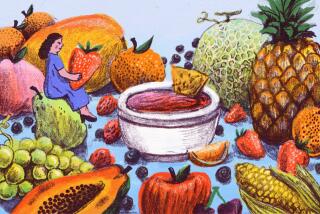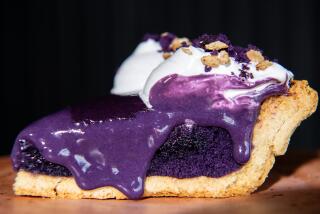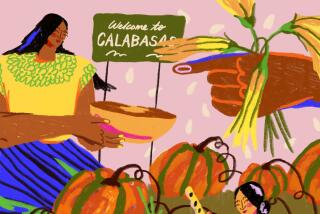A FRUITFUL FALL
- Share via
In Southern California, this land of two seasons, we sometimes need to be reminded just how good a pear can be. Summer’s peaches, grapes and melons seem to blend seamlessly into winter’s citrus fruits, and we forget about the fruits and times in between.
But there are moments when memories of fall ring clear and romantic. The smell of the first crisp morning. The bold scarlet and gold of changing leaves. In my nostalgic bliss, the drudgery of putting up storm windows and winterizing the car radiator conveniently slips from my mind.
For me, a good ripe pear conjures all the best of fall with none of the drudgery. The crisp winey flesh. The rich autumnal colors. The unbearable sweetness of it all.
Strangely enough, this symbol of fall is produced in some abundance in California. They are grown mainly in two areas--the River District, on the delta of the Sacramento River, and the Mountain District of Lake and Mendocino counties. Pears from the River District are prized because they are harvested first, beginning in mid-July. In August, the Mountain District harvest begins. Those pears are generally considered to be sweeter and juicier because of the chillier temperatures there.
Almost all the pears in California are Bartletts--named after the Philadelphia nurseryman Enoch Bartlett, who began selling it in this country in 1817. Actually, its roots go back even further. The Bartlett is identical to the English Williams pear (hence the liqueur poire Williams). Williams was the name of the London nurseryman who popularized it in the late 1700s. This is a fruit with history.
Right now, things in pear-land are really swinging, and by mid-October the California harvest is generally finished, just in time to get out of the way of the massive Pacific Northwest haul. Oregon harvests about twice as many pears as California, and Washington about three times as many. All tolled, the three West Coast states account for 95% of the U.S. pear harvest.
Pears are one of the few fruits that must be picked before it will begin to ripen. Left on the tree, a pear will get softer but it will not get sweeter. As a result, you’ll find a lot of green, underripe pears in the market. Most will ripen, but some will remain less than ideally ripe. When that happens, the fruit is perfect for a salad--crisp and with a flavor more herbal than sweet.
In this dish, the slivers of pear and fennel are almost indistinguishable, one complementing the other to make a combination that is better than either of them used singly. Arranged in a haystack atop the romaine, they provide a subtle gradation of color, from white to ivory to light green.
(BEGIN TEXT OF INFOBOX / INFOGRAPHIC)
FENNEL, PEAR AND WALNUT SALAD
Serves 6
2 pears, preferably slightly underripe
2 small bulbs fennel, trimmed
1 shallot, minced
2 tablespoons Champagne vinegar
1/2 teaspoon salt
2 ounces shelled walnut pieces, chopped
2 heads romaine lettuce
1/4 cup olive oil
Pears have to be firm for slicing. If preparing pears in advance, toss them with a little Champagne vinegar to keep from browning.
Cut unpeeled pears into quarters and remove seed and stem core. Thinly slice each pear quarter lengthwise. Cut slices into thin sticks.
Cut fennel bulbs in quarters and cut out core. Thinly slice fennel quarters lengthwise and then slice into thin sticks. Combine pears and fennel in large bowl.
Mix together minced shallot, vinegar and salt in small bowl and let stand 5 minutes.
Toast walnut pieces in small dry skillet over medium heat until fragrant, 3 to 5 minutes. Set aside to cool briefly.
Cut romaine in 1/2-inch crosswise strips and place in separate large bowl.
Whisk olive oil into shallot-vinegar combination. Add about 1/3 of mixture to lettuce and toss well. Taste and add more if needed. Lettuce should be only lightly coated; there should be no oil in bottom of bowl.
Add remaining vinaigrette to pear and fennel sticks, reserving about 1 tablespoon. Toss well. Taste and add remaining vinaigrette if necessary.
Divide lettuce among 6 chilled plates and arrange in clumps. Arrange pear and fennel sticks on top. Sprinkle with chopped walnuts.
Annie Glass plate and Siecle fork from Barneys New York
More to Read
Eat your way across L.A.
Get our weekly Tasting Notes newsletter for reviews, news and more.
You may occasionally receive promotional content from the Los Angeles Times.









